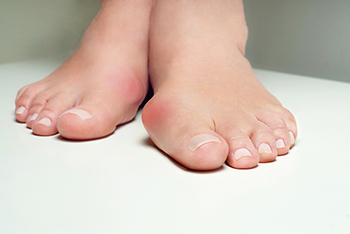
 A noticeable bump on the side of the big toe may indicate that a bunion has developed. This bony protrusion forms on the side of the big toe, while a bunionette forms on the side of the pinky toe and both can cause difficulty when wearing shoes. Common reasons patients can develop bunions may include wearing shoes that do not fit correctly and having a genetic predisposition for bunions. Some of the symptoms can consist of swelling near the bottom of the big toe, pain while wearing shoes, and the affected area may feel sore. There are several methods available to treat a bunion, and it is suggested that you consult with a podiatrist who can offer the best treatment options for you.
A noticeable bump on the side of the big toe may indicate that a bunion has developed. This bony protrusion forms on the side of the big toe, while a bunionette forms on the side of the pinky toe and both can cause difficulty when wearing shoes. Common reasons patients can develop bunions may include wearing shoes that do not fit correctly and having a genetic predisposition for bunions. Some of the symptoms can consist of swelling near the bottom of the big toe, pain while wearing shoes, and the affected area may feel sore. There are several methods available to treat a bunion, and it is suggested that you consult with a podiatrist who can offer the best treatment options for you.
If you are suffering from bunions, contact Dr. Thomas Tran of Southwestern Foot & Ankle Associates, P.C.. Our doctor can provide the care you need to keep you pain-free and on your feet.
What Is a Bunion?
A bunion is formed of swollen tissue or an enlargement of boney growth, usually located at the base joint of the toe that connects to the foot. The swelling occurs due to the bones in the big toe shifting inward, which impacts the other toes of the foot. This causes the area around the base of the big toe to become inflamed and painful.
Why Do Bunions Form?
Genetics – Susceptibility to bunions are often hereditary
Stress on the feet – Poorly fitted and uncomfortable footwear that places stress on feet, such as heels, can worsen existing bunions
How Are Bunions Diagnosed?
Doctors often perform two tests – blood tests and x-rays – when trying to diagnose bunions, especially in the early stages of development. Blood tests help determine if the foot pain is being caused by something else, such as arthritis, while x-rays provide a clear picture of your bone structure to your doctor.
How Are Bunions Treated?
If you have any questions, please feel free to contact our office located in Frisco, TX . We offer the newest diagnostic and treatment technologies for all your foot care needs.
Read more about BunionsCopyright © Southwestern Foot and Ankle Associates, P.C. | Site Map | Nondiscimination | Design by: Podiatry Content Connection